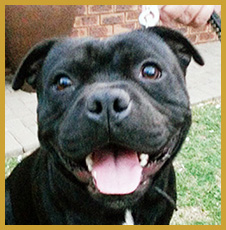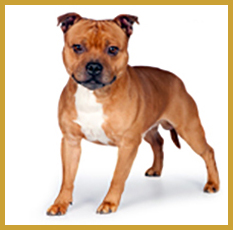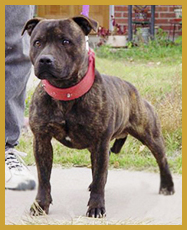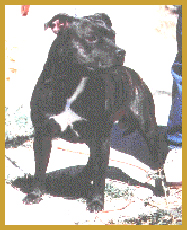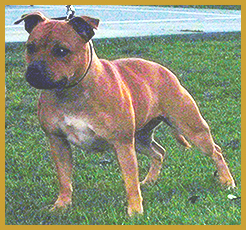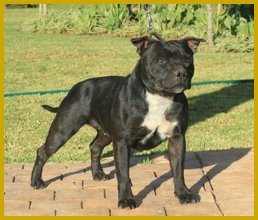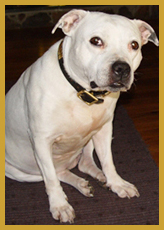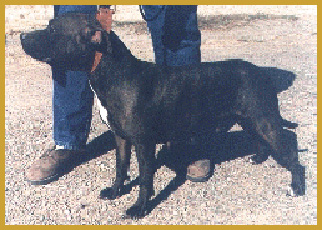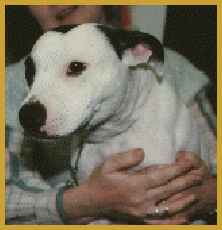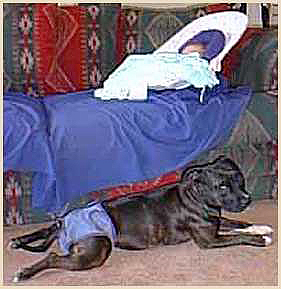How to train for Flyball
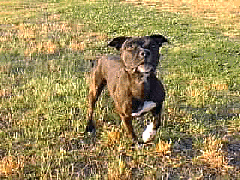
Jazz totally focused on her ball.
Submitted by Alisa Romaine and Jazz
Terry asked how to start flyball. Well, first of all, go to the NAFA site to see if there are teams in your area. To compete you will need a team. However, to get the basics down on your dog so once you join the team you can compete that much faster you can do the following:
This is basically how I trained Jazz and she was running the pattern by the time the team I was racing with at the time would allow her to come to official practice.
- You will need basic obedience - most important a GOOD solid recall.
- Start working on fetching drive if you don't already have it. A hallway is the best because you can pattern the fetch and the "lane behavior" at the same time. Close all the doors into the hallway. Hold the dog at one end of the hall and throw the ball - carefully. Once the ball is close to stopping release the dog telling it "go" or "get it". The commands are crucial because you will use them later to cue the dog when racing as to when it is about to run. If the dog can't focus far, then throw the ball close and gradually work up to the entire hallway. The hall is good because you are patterning the dog to go straight out and straight back - the pattern you need for flyball. Always call the dog's name once it has picked up the ball. You can also say "come" but for flyball, getting the dog to come on his name is faster in a race.
- When the dog is fetching real well, add in the words "mark, set" and then "go" or "get it". You would use these in racing as follows: Dog in front of you in lineup takes off down the lane toward the box, you tell your dog "mark"; dog hits box, you tell your dog "set", dog lands over first or second jump, you release your dog at same time as you say "go" or "get it". At this point, you can add in a low (6" or lower) jump near the middle of the hall so the dog gets used to jumping the jump with the ball in its mouth.
- To keep up dog's enthusiasm, also do some runs without holding dog so he can chase moving ball.
- Add in fetching in the yard where you don't hold dog, throw ball, run forward about 5-10 feet and when dog has ball, call name and turn and run. Dog should chase you down whereupon you have a "party" and then go again.
All this you can do with basically no flyball equipment except for a ball. Now, if you have located a team, you have a dog who is basically trained and it should take little time to get it used to jumping the jumps and running with a team.
If you all are interested in how to train a dog to hit the box when you don't have a box, speak up and I'll let you in on how I trained Jazz on that as well! Works great.
Let's go flyball Staffords!
BOX WORK
The Basics
Had several replies wanting to know how to train the box so here goes. Now remember all this stuff you are doing is just setting the groundwork for training on real equipment with a racing team. If you are really nuts about it you can build jumps and purchase a good box - usually around $300 US and up. Yes, Jazz does have her own box and two sets of jumps! :-0
Ball sizes: On the ball size, when Jazz was little I used a small 2" diameter ball but as she got older we switched to tennis balls. However, the NAFA rules state that any ball that responds similar to a tennis ball can be used. So, if you want to use racquet balls and the like, that is perfectly permissible. In fact, when playing fetch with Jazz, I will often use different types of balls so that she understands that balls are balls are balls. She will now bring me anything remotely resembling a ball to throw for her.
Box work: Get a big fluffy pillow and lay it on the floor. Stand beside the pillow with the ball or a treat and entice the dog to put its feet on the pillow. As soon as the feet hit the pillow, the dog gets the treat and/or you throw the ball away from the pillow so that the dog has to turn and go back the way he came. Try to wean the dog from the treats to chasing the ball if you begin with treats. After a few repetitions of this begin telling the dog "go push" as you lure it over to the pillow. If the dog begins to stop short of the pillow, back up and start over making your lure very obvious over the pillow. Once the dog really understands this command, begin standing away from the pillow and sending the dog to the pillow as though it were the box with the command "go push". Again, you may have to start close (like 10 inches) and then work back from there. Eventually you can stand quite a ways away, aim the dog towards the pillow, give the command, and he will "go push". The idea with throwing the ball is to get the idea in the dog's mind that when he hits the pillow/box to get off of it asap and get his ball. By patterning the behavior, you should get a dog who will easily transfer the push to a flyball box and not spend any time hanging on the box after getting the ball. In fact, Jazz has caught the ball over her shoulder on occasion when the box has been too slow and she's already leaving the box when the ball came out! Needless to say, we now have a faster box!!! This behavior can transfer into a cute little game if you want to amaze your non-Stafford friends. I'll point to my hip and tell Jazz "Push" and she will leap up and do a box push on me! I constantly hear "Wow, she can really jump".
This is a lot of fun and, if nothing else, it makes the dog think and work with you as a team which makes training absolutely anything else that much easier.
Questions?
Alisa
Flyball Box Work - Intermediate
Well all, now that you've all been working on "Push" with the pillow, I thought it time to tell you how to teach the dog to grab the ball from the box. First, I wanted to relate a funny that I did with Jazz after she had learned the "push" drill. I was pretty excited that she was translating the "Push" command to anything I pointed at. That evening my husband lay down on the floor to watch television and I couldn't resist. I called Jazz over quietly, pointed at my husband's butt and told her "Go Push". Jazz ran over and did a perfect box push on my husband. Boy was he surprised! :-0 See how entertaining these behaviors can be. :-)
Because flyball is a speed sport, it is important to teach the dog to get off the box fast (Push) and to grab the ball instead of hitting the pedal and letting the ball fly out and then catching it. Most dogs' times are slower because they spend too much time at the box - not because they are necessarily running slow (although that does happen too). So, to teach the dog to reach and grab the ball as he is hitting the box pedal, try the
following:
Hopefully most of you have a couch/sofa with seat cushions that are detached near the center of the couch. Take the ball and place it between the cushions so that it is sticking out quite a bit but still held by the cushions. You can also put the ball under the main cushion if it isn't sticking out too far from the couch frame. The dog has to be able to see the ball clearly and be able to grab it. Take your dog and set him up 3-5 feet from the couch directly in front of the ball. Give him his commands, "Mark, Set, Go" or "Get it". As soon as dog grabs the ball, call his name. If you have room, you can run back a couple feet. If not, don't worry. We aren't patterning the chase right now, just the ball grab. Do this for several days with the ball sticking out of the cushions. Next, push the ball further back into the cushions so that the dog has to grab it harder to get it out of the cushions. He still needs to be able to see the ball clearly. You can continue to push the ball further into the cushions until none of the ball is sticking out of the cushions and the dog really has to reach in and grab the ball. If the dog is also grabbing the cushions, then they are not firm enough to do this drill or the ball is pushed too far into the couch cushions. The grab translates into less time spent at the box because as the dog approaches the box, he will put his mouth on the ball instead of waiting for it to be pushed out to him. So, as soon as his feet contact the pedal, he will be thinking about getting off the box (the Push drill), his mouth is on the ball so it is instantly in his mouth - and you have patterned a great box turn!
Let's Race.
Alisa Romaine
